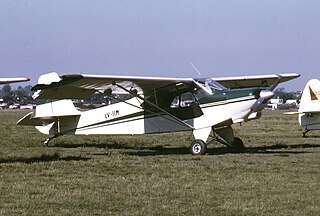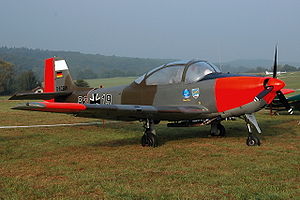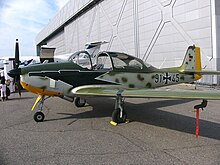
The Focke-Wulf Fw 44 Stieglitz (Goldfinch) is a 1930s German two-seat biplane. Designed by Kurt Tank in 1931, it was the Focke-Wulf company's first major international success. Produced as a pilot training and sports flying aircraft. It was also built under license in several other countries.

The Focke-Wulf Fw 58 Weihe (Harrier) was a German aircraft, built to fill a request by the Luftwaffe for a multi-role aircraft, to be used as an advanced trainer for pilots, gunners and radio operators.

The Lavochkin La-5 was a Soviet fighter aircraft of World War II. It was a development and refinement of the LaGG-3, replacing the earlier model's inline engine with the much more powerful Shvetsov ASh-82 radial engine. During its time in service, it was one of the Soviet Air Force's most capable types of warplane, able to fight German designs on an equal footing.

The Aermacchi AM.3 was the result of a joint venture between Aermacchi and Aeritalia in response to an Italian Army requirement for an aircraft to replace the Cessna L-19, and was initially designated the MB-335.

The SAI KZ III Lærke ("lark") was a Danish light utility aircraft used by the Danish Air Ambulance Service and Danish Air Force.

The Piaggio PD.808 was an Italian business jet built by Piaggio. It was designed as a joint venture between Piaggio and Douglas Aircraft Company of Long Beach, California, United States.

The Savoia-Marchetti S.74 was a four-engine airliner developed by Savoia-Marchetti for Ala Littoria.

The Sukhoi Su-12 was a prototype Soviet reconnaissance and artillery spotter aircraft developed during World War II.

The Malmö Flygindustri MFI-9 Junior was a light aircraft produced in Sweden in the 1960s. The aircraft was also produced under licence in West Germany as the Bölkow Bo 208.

The Piaggio P.166 is an Italian twin-engine pusher-type utility aircraft developed by Piaggio Aero. The aircraft model name was Portofino, and is also known as Albatross in South African military service.
The Auster Avis was a four-seat light aircraft developed from the Auster Autocrat. It featured a redesigned fuselage incorporating four doors and a circular cross-section towards the tail, new undercarriage, and new wing flaps. It was planned in two versions, the Mk 1 for civil use, and the Mk 2 for military and air ambulance duties. However, only two prototypes were built, and Auster abandoned the project in favour of the Auster J-5 Autocar.

The Bölkow Bo 207 was a four-seat light aircraft built in West Germany in the early 1960s, a development of the Klemm Kl 107 built during World War II.

The Piaggio P.136 was an Italian twin-engine amphibian flying boat designed and manufactured by aircraft company Piaggio Aero. It is furnished with an all-metal hull, pusher propellers, a gull wing, and retractable landing gear.

The MBB 223 Flamingo was a light aircraft developed in West Germany in the 1960s in response to a competition for a standard trainer for the country's aeroclubs. Designed by SIAT, it was a conventional low-wing monoplane with fixed tricycle undercarriage. The cockpit was enclosed by a large bubble canopy. SIAT had not undertaken much production of the type before the firm was acquired by MBB in 1970. Eventually, the new owners transferred production to CASA in Spain.

The DINFIA IA 35 Huanquero was a 1950s Argentine twin-engined general-purpose monoplane aircraft built by the DINFIA.

The DINFIA IA 46 Ranquel, IA 46 Super Ranquel, and IA 51 Tehuelche were Argentine utility aircraft developed in the late 1950s.

The SAI KZ VII Lærke was a light utility aircraft built in Denmark shortly after the Second World War. Based on the SAI KZ III air ambulance, the KZ VII was a strut-braced, high-wing monoplane of conventional design with an enclosed cabin for four seats. Fifty-six aircraft were built, and another 22 partially completed aircraft were destroyed in a factory fire in 1947. The Danish Air Force operated 10 of the type as trainers between 1950 and 1977.

The DFS Kranich is a type of German glider. It was developed by Hans Jacobs for the Deutsche Forschungsanstalt für Segelflug (DFS).

The DFS Weihe is a German single-seat, high-wing, 18 metre wingspan, high-performance glider that was designed by Hans Jacobs in 1937-38.

The Aviamilano F.14 Nibbio is a four-seat, single engine cabin monoplane built in Italy in the late 1950s. Only ten production aircraft were completed.























